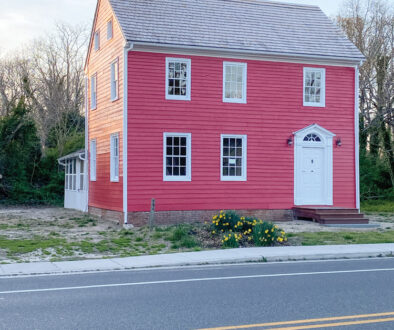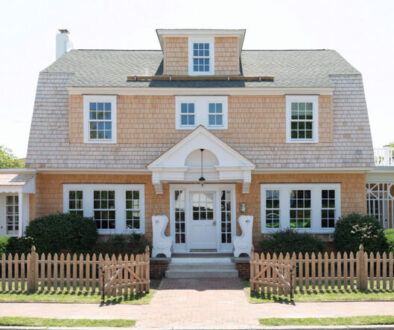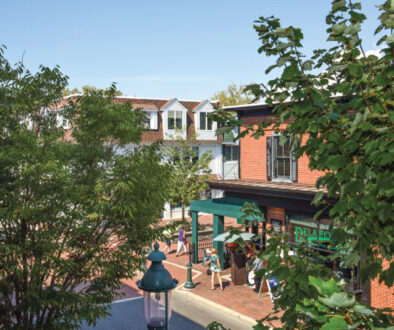Going Gray
Once upon a time, in the not-so-distant past, people thought the color gray was pretty depressing. We wanted nothing to do with it, as a paint color or a hair color. Gray, in fact, literally seemed to represent the exact opposite of what we wanted in our lives: where we wanted light and sunshine, gray was dour, drab, and old.
And then just like that, in what seemed a snap of the fingers, gray took on new life. Suddenly we were seeing every imaginable shade of gray everywhere, from interiors and exteriors to hair dyes. And while the gray trend started a while ago, it’s become a ubiquitous hue.

“I don’t think it will ever go out of style,” says Erin Daniels of Cape May Decorating Co. “I think one reason gray is so popular is that it’s really accessible and it feels fairly easy to pick. People get overwhelmed with color. You can work gray into a lot of different schemes a little easier.”
Daniels should know. A longtime watercolor artist, she began doing color consultations—as well as interior design—several years ago, first through Sherwin Williams, and then independently. The color consultation portion of her services grew so busy that it has become her primary focus.
“I’m an artist, first and foremost,” says Daniels. “So, I’ve been using color basically my whole life.”
For those in need of a color consultant, the process with Daniels involves a 90-minute on-site color consultation. “There are so many variables that can affect color.”
Daniels explains that everything in a home, from the direction of the room (is it north facing or south facing?), to the natural light, to the number of trees outside (the reflection of the green will change the color of your walls), to the flooring color (which will reflect up onto the walls and change the color) can all affect the way paint looks on the walls.
“That’s why I do the color consultations onsite. I want to be in the space,” she says.
Daniels often consults with homeowners who have a flair for decorating but who are stuck with 50 paint swatches on the wall. Likewise, she’ll work with painters and builders on new builds.
“We just work together narrowing down how they want the house to feel,” says Daniels. “I find it easier for people to describe how they want it to feel than how they want it to look.”
And while Daniels is a huge proponent of color, she understands the allure of neutrals. “Gray has definitely been the ‘in’ color,” says Daniels.
Though she sees things going towards warmer neutrals, Daniels doesn’t dismiss the charm of gray. “There are definitely ways to use it, especially here in a coastal palette,” says Daniels. “It’s very clean looking. If done right, it can be very sophisticated. It’s just a matter of getting the right gray and pairing it with the right colors.”
The thing about the color gray is that it can range from drab to cozy to elegant to bold. “Gray can go either way,” says Daniels about the hue’s versatility. “I’ll ask people ‘how do you want your master bedroom to feel?’ If the answer is relaxing and soft but light and bright, spa-like, Sea Salt by Sherwin Williams could be your color. It’s technically a gray, but it has a bit of green and a bit of blue in it, so depending upon how the light hits it, it can go either way. It’s a beautiful color, a great neutral without being just a flat gray. It’s a light color, not depressing at all.”
While gray can be spa-like, almost ethereal, and a reflection of the sand, water, and sky at the shore—the perfect backdrop to the white slip-covered furniture and jute rugs of many coastal homes—it can also be bold and daring.
“If you go to the total opposite end, there is a British paint company called Farrow and Ball, and they have a color called Railings, which is really, really, really dark gray, almost black, but it has some blue in it, which is super dramatic and moody,” says Daniels. “It just depends on the look you’re going for. I don’t use dark colors like that very often in the coastal homes that I do, but in a historic home or a home on the mainland, it’s definitely the kind of color that is hot right now.”
Of course, these are far from the only grays, and are not the only ones Daniels uses or recommends. All of that has to do with the aforementioned variables which can change the look of a paint color.
“People say, ‘Oh, my friend used Sea Salt and it looks great, but I tried it and it looks terrible,” says Daniels. “I might have someone with that 1990s reddish oak wood flooring and trim, and they want to paint everything a cool gray. Well, that cool gray is not going to complement that kind of orangey oak. So, I try to steer them more towards a ‘greige,’ which is a grayish beige.”
In that case, Daniels suggests that a greige such as Modern Gray from Sherwin Williams or Edgecomb Gray from Benjamin Moore might work.
Like other colors, gray doesn’t work in a vacuum. And though Daniels stresses a décor style that flows through the house, it also doesn’t have to be monochromatic.

“One thing I like for coastal homes, if people want a gray like Sea Salt, is when they go a bit bolder with the accent,” says Daniels. “It’s fine to pick a nice neutral for the walls and then you can have a little fun with the decorating. It frees you up to do something a little more fun. You can use aqua and coral with gray, which is a nice combination. Another of my favorite combinations if you use more of a greige on the wall is to use crisp navy and white. It’s a classic. You can’t go wrong with that.”
Additionally, there’s the use of gray without any obvious gray around. It turns out that gray is present in many paint colors, as it’s often used to mute a brighter tone.
“Maybe someone has this beautiful soothing palette in their home and then you get to the bedroom, and they want a bright purple—something incongruous with the rest of the palette,” says Daniels. “I can show them some lavenders with a bit of gray in them.”
“My job is to show people how they can use color, even if it’s just a hint of it—a gray with a hint of blue or a hint of green,” says Daniels. “What people like about gray is that it’s soft, it’s soothing. I don’t know that it’s always just the gray, but more the feeling they get from gray. So I can show them some great colors that have gray in them.”
If your plan is to utilize gray in other areas of your décor, Daniels suggests upholstery. “It’s not a bad thing to have a neutral upholstery, like a gray or a linen color, or something to give your eye a rest,” says Daniels. “Having a lot of pattern and color can be too busy.”
“My job is to show people how they can use color, even if it’s just a hint of it.”
Daniels herself has two gray chairs. “I have a lot of color and wanted a neutral,” she says. “I picked the paint from the Benjamin Moore Historical Collection, which I don’t think you can go wrong with.”
And though gray has even been making quite the appearance on floors—particularly on driftwood vinyl planks—Daniels urges caution.
“You have to really love gray to put it on your floor. It determines the entire palette for your house if flooring is a color,” says Daniels. “Flooring isn’t something you want to replace in five years. I feel like big, permanent or semi-permanent surfaces aren’t the places to go trendy.”
The takeaway, of course, is like all design takeaways: personal preference. As Daniels says, “It’s really a matter of how people want their house to feel.”



